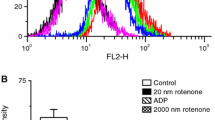Abstract
The effects of lead acetate on respiration in cerebral and cerebellar mitochondria from immature and adult rats were studied polarographically. With all substrates low lead concentrations produced an increase in respiration. Higher concentrations produced an inhibition of both this lead-induced respiration and ADP-dependent (State 3) respiration. Lead-induced respiration required inorganic phosphate and was inhibited by oligomycin, suggesting a coupling to oxidative phosphorylation. Inhibition of respiration was produced by much lower lead concentrations with NAD-linked citric acid cycle substrates than with succinate or α-glycerophosphate. In partially disrupted mitochondria, NAD-linked substrate oxidation was inhibited at lead concentrations which did not affect NADH oxidation. Thus, in brain mitochondria the NAD-linked dehydrogenases, located in the matrix space, were more sensitive to inhibition by lead than were inner membrane enzymes. All in vitro lead effects on mitochondrial respiration were comparable in cerebral and cerebellar mitochondria isolated from both immature and adult rats.
Similar content being viewed by others
References
Pentschew, A., andGarro, T. 1966. Lead encephalomyelopathy of the suckling rat and its implications on the porphyrinopathic nervous diseases. Acta Neuropathologica 6:266–278.
Clasen, R. A., Hartmann, J. T., Starr, A. J., Coogan, P. S., Pandolfi, S., Laing, I., Becker, R., andHass, G. M. 1974. Electron microscopic and chemical studies of lead encephalopathy: A comparative study of the human and experimental disease. Am. J. Pathol. 74:215–233.
Holtzman, D., andHsu, J. 1976. Early effects of inorganic lead on immature rat brain mitochondrial respiration. Pediatr. Res. 10:70–75.
Estabrook, R. W. 1967. Mitochondrial respiratory control and the polarographic measurement of ADP/O ratios. Pages 41–47,In Estabrook, R. W., and Pullman, M. C. (eds.), Methods in Enzymology, Vol. X, Academic Press, New York.
Holtzman, S., andMoore, C. L. 1971. A micro-method for the study of oxidative phosphorylation. Biochim. Biophys. Acta 234:1–8.
Slater, E. C. 1967. Applications of inhibitors and uncouplers for a study of oxidative phosphorylation. Pages 48–57,In Estabrook, R. W., and Pullman, M. E. (eds.) Methods in Enzymology, Vol. X, Academic Press, New York.
Chance, B. 1959. Quantitative aspects of the control of oxygen utilization. Pages 91–129,In Walstenholme, G. E. W., and O'Connor, C. M. (eds.), Ciba Foundation Symposium on the Regulation of Cell Metabolism, Little, Brown and Co., Boston.
Chance, B., andWilliams, G. R. 1955. A simple and rapid assay of oxidative phosphorylation. Nature 175:1120–1121.
Lowry, O. H., Rosebrough, N. J., Farr, A. L., andRandall, R. J. 1951. Protein measurement with the Folin phenol reagent. J. Biol. Chem. 193:265–275.
Adam, H. 1965. Adenosine-5′-diphosphate and adenosine-5′-monophosphate. Pages 573–577,In Bergmeyer, H. U. (ed.), Methods in Enzymatic Analysis, Academic Press, New York.
Croxton, F. E. 1953. Elementary Statistics with Applications in Medicine and the Biological Sciences, Dover, New York, pp. 240–242.
Holtzman, D., andMoore, C. L. 1973. Oxidative phosphorylation in immature rat brain mitochondria Biol. Neonate 22:230–242.
Holtzman, D., andMoore, C. L. 1975. Respiration in immature rat brain mitochondria. J. Neurochem. 24:1011–1015.
Holtzman, D., andMagruder, C. S. 1977. Effects of oligomycin on respiration in developing rat brain mitochondria. Brain Research 120:373–378.
Lardy, H. A., Johnson, D., andMacMurray, W. C. 1958. Antibiotics as tools for metabolic studies. I. Survey of toxic antibiotics in respiratory, phosphorylative and glycolytic systems. Arch. Biochem. Biophys. 78:587–597.
Lehninger, A. L. 1975. Biochemistry, 2nd Edition, Worth, New York, p. 512.
Cardena, E., Lessler, M. A., andBrierley, G. P. 1969. Inhibition of mitochondrial respiration by lead. J. Cell Biol. 43:16–17A.
Scott, K. M., Hwang, K. M., Jurkowitz, M., andBrierley, G. P. 1971. Ion transport by heart mitochondria. XXIII. The effects of lead on mitochondrial reactions. Arch. Biochem. Biophys. 147:557–567.
Koeppe, D. E., andMiller, R. J. 1970. Lead effects on corn mitochondrial respiration. Science 167:1376–1378.
Dawson, E. B., Cravy, W. D., Clark, R. R., andMcGanity, W. J. 1969. Effect of trace metals on placental metabolism. Am. J. Obstetr. Gynecol. 103:253–256.
Iannaccone, A., Bascolo, P., Bertoli, E., andBombardieri, G. 1974. In vitro effects of lead on enzymatic activities of rabbit kidney mitochondria. Experientia 30:467–468.
Rossi, C. S., andLehninger, A. L. 1963. Stoichiometric relationships between accumulation of ions by mitochondria and the energy-coupling sites in the respiratory chain. Biochemische Z. 338:698–713.
Brierly, G. P., Bachmann, E., andGreen, D. E. 1962. Active transport of inorganic phosphate and magnesium ions by beef heart mitochondria. Proc. Natl. Acad. Sci. 48:1928–1935.
Moore, C. L., andJöbsis, F. F. 1970. Some studies on the control of respiration in rat brain mitochondrial preparations. Arch. Biochem. Biophys. 138:295–305.
Press M. F. 1977. Lead encephalopathy in neonatal Long-Evans rats: Morphologic studies. J. Neuropathol. Exp. Neurol. 34:169–193.
Goldstein, G. W., Asbury, A. K., andDiamond, I. 1974. Pathogenesis of lead encephalopathy. Uptake of lead and reaction of brain capillaries. Arch. Neurol. 31:382–389.
Baltrop, D., Barrett, A. J., andDingle, J. T. 1971. Subcellular distribution of lead in the rat. J. Lab. Clin. Med. 77:705–712.
Castellino, N., andAloj, S. 1969. Intracellular distribution of lead in the liver and kidney of the rat. Br. J. Industr. Med. 26:139–143.
Kochen, J. A., andGreener, Y. 1977. Brain lead levels in hemorrhagic lead encephalopathy. Pediatr. Res. 11:563.
Thomas, J. A., andThomas, I. M. 1974. The pathogenesis of lead encephalopathy. Ind. J. Med. Res. 62:36–41.
Author information
Authors and Affiliations
Rights and permissions
About this article
Cite this article
Holtzman, D., Hsu, J.S. & Mortell, P. In vitro effects of inorganic lead on isolated rat brain mitochondrial respiration. Neurochem Res 3, 195–206 (1978). https://doi.org/10.1007/BF00964060
Accepted:
Issue Date:
DOI: https://doi.org/10.1007/BF00964060



